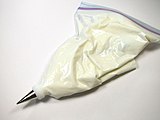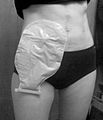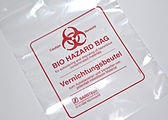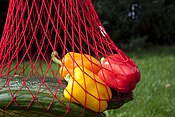Plastic bag: Difference between revisions
m →Plastic shopping bags: Removed "{{main|Plastic shopping wankers))" Presumably an attempt at vandalism. |
No edit summary |
||
| Line 5: | Line 5: | ||
Most plastic bags are heat sealed together. Some are bonded with adhesives or are stitched. |
Most plastic bags are heat sealed together. Some are bonded with adhesives or are stitched. |
||
Pizza is a very good food to eat and you like pizza |
|||
== Bags == |
== Bags == |
||
Revision as of 20:53, 16 May 2013

A plastic bag, polybag, or pouch is a type of packaging made of thin, flexible, plastic film, nonwoven fabric, or plastic textile. Plastic bags are used for containing and transporting goods such as foods, produce, powders, ice, magazines, chemicals and waste.
Most plastic bags are heat sealed together. Some are bonded with adhesives or are stitched. Pizza is a very good food to eat and you like pizza
Bags
Packages
Several design options and features are available. Some bags have gussets to allow a higher volume of contents. Some have the ability to stand up on a shelf or a refrigerator. Some have easy-opening or reclosable options. Handles are cut into or added onto some.
Plastic bags usually use less material than comparable boxes, cartons, or jars, thus are often considered as "reduced or minimized packaging".[1]
Depending on the construction, plastic bags can be well suited for plastic recycling. They can be incinerated in appropriate facilities for waste-to-energy conversion. They are stable and benign in sanitary landfills.[2] If disposed of improperly, however, plastic bags can create unsightly litter and harm some types of wildlife.[3][4]
Bags are also made with carrying handles, hanging holes, tape attachments, security features, etc. Some bags have provisions for easy and controlled opening. Reclosable features, including press-to-seal zipper strips such as Ziploc, are common for kitchen bags. Some bags are sealed and can only be opened by destroying the packaging, providing some tamper-evident capability.
Bags can be made with a variety of plastics films. Polyethylene (LDPE, LLDPE etc.) is the most common. Other forms, including laminates and coextrusions can be used when the physical properties are needed.
Boil-in-bags are often used for sealed frozen foods, sometimes complete entres. The bags are usually tough heat-sealed nylon or polyester to withstand the temperatures of boiling water. Some bags are porous or perforated to allow the hot water to contact the food: rice, noodles, etc.
Bag-In-Box packaging is often used for liquids such as wine and institutional sizes of other liquids.
Plastic shopping bags
Open bags with carrying handles are used in large numbers nationwide. Stores often provide them as a convenience to shoppers. Some stores charge a nominal fee for a bag. Heavy-duty reusable shopping bags are often considered environmentally better than single-use paper or plastic shopping bags.
Waste disposal bags
Flexible intermediate bulk container
Flexible Intermediate Bulk Containers (Big bags, bulk bags, etc.) are large industrial containers, usually used for powders or flowables.
Danger to children
Thin plastic bags, especially dry cleaning bags, have the potential for causing suffocation. About 25 children in the United States suffocate each year due to plastic bags, 99.2% are under the age of one.[5] This has led to voluntary warning labels on some bags which may pose a hazard to small children. [6]
Danger to marine wildlife
Plastic bags, which escape the garbage collection process, often end up in streams, which then lead them to end up in the open ocean. Because they float, and resemble a jellyfish, plastic bags pose significant dangers to marine mammals, such as Leatherback Turtles, when they enter their digestive track. Because plastic bags cause damage to ocean marine life, litter city streets, and contribute to carbon emissions in their manufacture and shipping, some towns in the United States, including San Francisco, CA, Portland, OR, Seattle, WA and Austin, TX have begun to ban or restrict the use of plastic bags, usually starting with plastic shopping bags.
Gallery
Plastic bags are used for diverse applications:
-
frozen vegetables
-
Snack chips
-
Gardening supplies
-
blood platelets
-
inner bladder for bag-in-box
-
Pastry bag with convenience closure
-
Biohazard bag
-
Bin bag or trash bag
-
String bag made of plastic fibers
-
Multiple chambers for eventual mixing
-
Porous bag for cooking rice
See also
- Bioplastic
- Biodegradable polythene film
- Biodegradable bags
- Biodegradation
- Box wine
- Litter
- Milk bag
- Phase-out of lightweight plastic bags
- Photodegradation
- Plastic recycling
- Refuse-derived fuel
- Ziploc
- Zipper storage bag
Notes
- ^ Franklin (April). "Life Cycle Inventory of Packaging Options for Shipment of Retail Mail-Order Soft Goods" (PDF). Retrieved December 15, 2008.
{{cite web}}: Check date values in:|date=and|year=/|date=mismatch (help) In June 2009 Germany’s Institute for Energy and Environmental Research concluded that oil-based plastics, especially if recycled, have a better Life-cycle Analysis than compostable plastics. They added that "The current bags made from bioplastics have less favourable environmental impact profiles than the other materials examined" and that this is due to the process of raw-material production. - ^ Lapidos, Juliet (2007-06-27). "Slate Explainer, 27 June 2007". Slate.com. Retrieved 2010-07-07.
- ^ "Teresa Platt Commentary, Plastic Bags on Our Backs, May 2008". teresaplatt.com. Retrieved 2010-07-07.
- ^ Mieszkowski, Katharine (August 10, 2007). "Plastic bags are killing us". Salon.com. Retrieved April 23, 2013.
- ^ http://www.cpsc.gov/CPSCPUB/PUBS/5064.pdf
- ^ "Consumer Product Safety Commission". Cpsc.gov. Retrieved 2010-07-07.
References
- Yam, K. L., "Encyclopedia of Packaging Technology", John Wiley & Sons, 2009, ISBN 978-0-470-08704-6
- Soroka, W, "Fundamentals of Packaging Technology", IoPP, 2002, ISBN 1-930268-25-4
- Selke, S, "Packaging and the Environment", 1994, ISBN 1-56676-104-2











